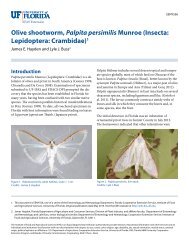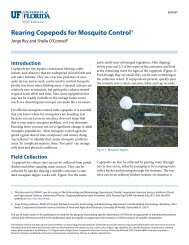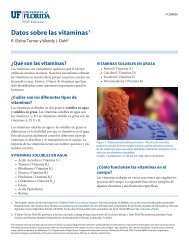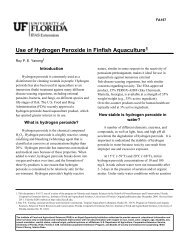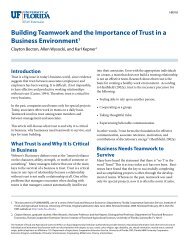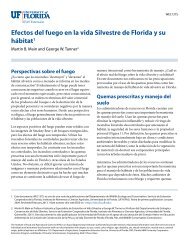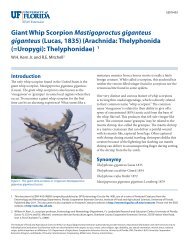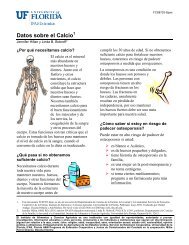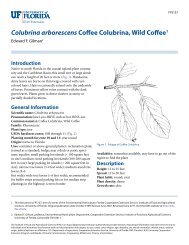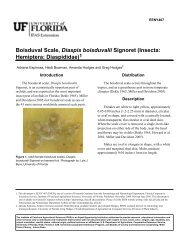Florida Dampwood Termites, Neotermes castaneus - EDIS ...
Florida Dampwood Termites, Neotermes castaneus - EDIS ...
Florida Dampwood Termites, Neotermes castaneus - EDIS ...
Create successful ePaper yourself
Turn your PDF publications into a flip-book with our unique Google optimized e-Paper software.
<strong>Florida</strong> <strong>Dampwood</strong> <strong>Termites</strong>, <strong>Neotermes</strong> <strong>castaneus</strong> (Burmeister), <strong>Neotermes</strong> jouteli (Banks),.... 4<br />
Figure 9. <strong>Neotermes</strong> <strong>castaneus</strong> (Burmeister) soldier.<br />
Credits: Rudolf H. Scheffrahn, University of <strong>Florida</strong><br />
1b. Eye facets darkly pigmented or faintly<br />
darkened; third antennal article clavate, longer than<br />
second or fourth (Figure 11). . . . . 2<br />
2a. Antennal carinae rugose and markedly<br />
protruded; eyes elongate, without satellite facets;<br />
setae on basal mandibular humps distinct (Figure 12).<br />
. . . . N. jouteli<br />
2b. Antennal carinae smooth and only<br />
moderately protruded; eyes subcircular, with satellite<br />
facets; setae on basal mandibular humps vestigial or<br />
absent (Figure 13). . . . . N. luykxi<br />
Life History<br />
As with most other members in the termite<br />
family Kalotermitidae, species of <strong>Neotermes</strong> build<br />
networks of galleries that meander through the wood<br />
in which they are hidden. Alates leave mature<br />
colonies via multiple dispersal flights over<br />
"swarming" seasons that can last for several months.<br />
<strong>Neotermes</strong> jouteli and N. luykxi tend to disperse in the<br />
late spring or summer, while N. <strong>castaneus</strong> has peak<br />
flights in the late fall or early winter. Flights occur at<br />
dusk or at night. <strong>Dampwood</strong> termites are relatively<br />
strong fliers and, like most nocturnal flying insects,<br />
are attracted to lights. Porch lights, indoor lights, and<br />
video monitors often lure the alates inside, especially<br />
when doors and unscreened windows are opened.<br />
When alates are found indoors, their origin is usually<br />
from a yard tree or a woodland colony. Occasionally,<br />
alates found indoors originate from an infestation in<br />
the structure itself. However, alates flying indoors are<br />
unlikely to find the moist wood they need for<br />
successful colonization, and are doomed.<br />
Figure 10. Eye facets unpigmented; third antennal article<br />
not clavate, similar to second and fourth. . . . . <strong>Neotermes</strong><br />
<strong>castaneus</strong> (Burmeister) Credits: Rudolf H. Scheffrahn,<br />
University of <strong>Florida</strong><br />
Figure 11. Eye facets darkly pigmented or faintly<br />
darkened; third antennal article clavate, longer than second<br />
or fourth. Credits: Rudolf H. Scheffrahn, University of<br />
<strong>Florida</strong>



